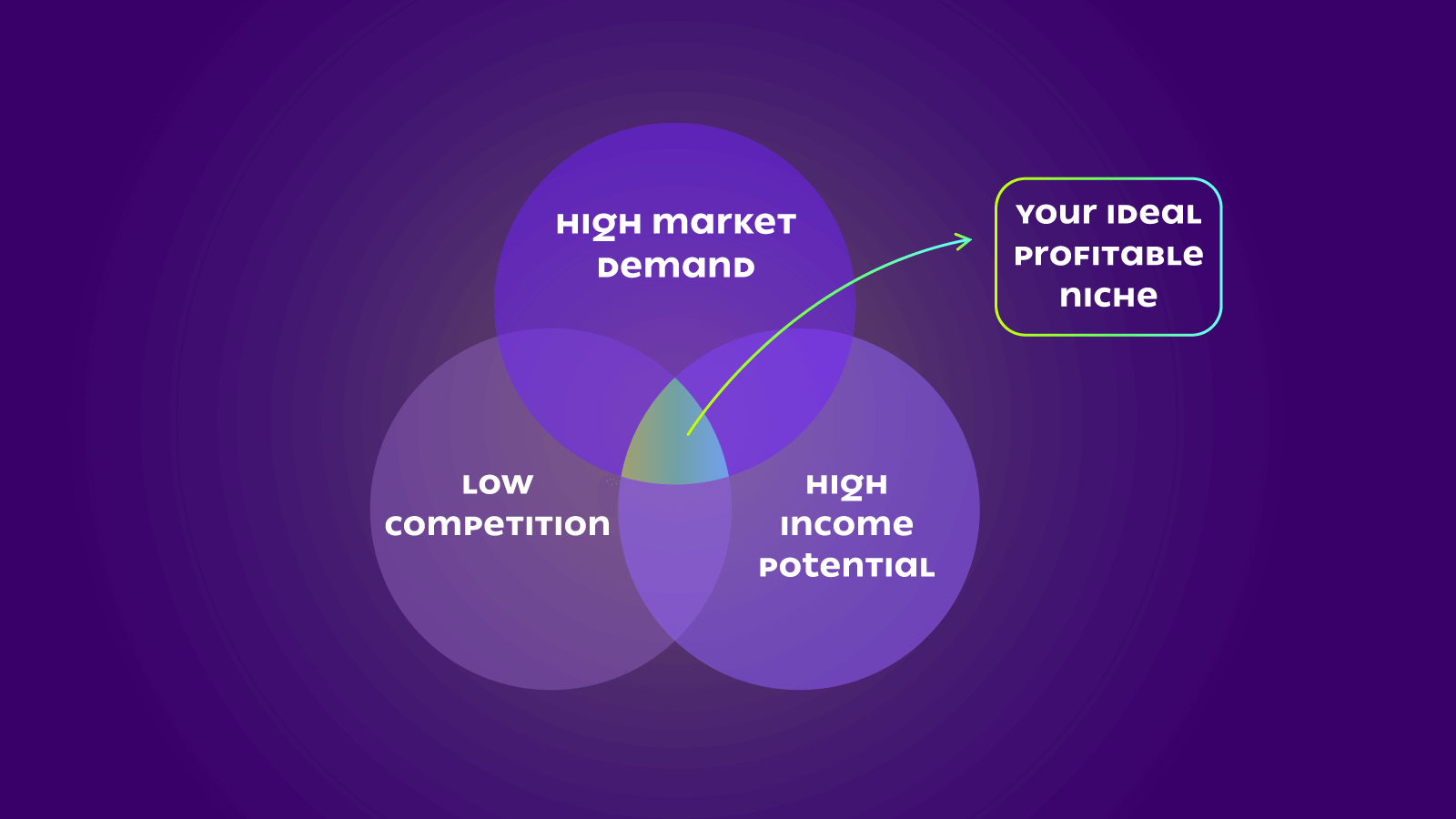If you’re reading this, you’re probably aware that a one-size-fits-all approach in social media marketing just doesn’t cut it, especially when you’re dealing with a niche market. But what makes niche marketing so unique, and why do standard tactics often fall short?
Let’s take a coffee shop as an example. If this coffee shop specializes in organic, locally-sourced brews, their target audience isn’t just any coffee drinker. They’re looking for environmentally conscious, health-aware coffee enthusiasts.

This is where niche marketing comes into play: honing in on that specific group of people who are looking for exactly what you offer.
Think of social media as a bustling marketplace. In a sea of stalls (or in our case, posts and ads), your job is to make sure that the right people stop at your stall. This means understanding who they are, what they like, and how they use social media.
Do they hang out more on Instagram or LinkedIn? Do they prefer engaging stories or straight-to-the-point posts?
So in this guide, we’re diving into advanced strategies that go beyond the basics. We’ll explore how to grab the attention of your niche market and keep them engaged, turning them not just into customers, but into advocates for your brand.
Whether you’re marketing artisanal cheese or high-tech gadgets, these strategies are designed to help you grow your presence where your niche audience lives and thrives on socials.
Start by Truly Understanding Your Niche Market

The first step is to truly understand your target audience. Identifying your audience goes beyond just knowing their age or location. It’s about diving deep into their interests, needs, and online behaviors.
Let’s say your business specializes in eco-friendly athletic wear.
Your target audience isn’t just people who exercise; it’s more specific. You’re looking for fitness enthusiasts who are passionate about sustainability.
Once you’ve pinpointed who your audience is, the next step is to understand how they behave on social media.
- Are they more likely to engage with Instagram stories or LinkedIn articles?
- Do they prefer visually-rich content or detailed blog posts shared on social media?
Analyzing their behavior can involve looking at engagement patterns on similar pages, conducting surveys, or even using social media analytics tools.
For example, if you find that your eco-conscious fitness enthusiasts are highly active on Instagram and engage most with posts about sustainable living practices, you’ve hit a goldmine of information.
This knowledge allows you to tailor your social media content to match their preferences, ensuring that your posts resonate with the very people you want to attract.
Mark McShane, Founder of First Aid at Work Course, said, “Understanding your niche market is about getting into the nitty-gritty of who your audience is and how they interact with social media. This foundation is crucial for building an effective and targeted social media strategy.”
Create Engaging Customized Content

Creating content that speaks directly to your niche audience is like crafting a personalized invitation to your brand’s world. It’s about striking that perfect balance between what your audience loves and what your brand stands for.
Let’s take the eco-friendly athletic wear brand again.
Instead of generic workout tips, your content could be about eco-friendly exercise routines, highlighting sustainable fitness influencers, or sharing stories about how sustainable materials make a difference.
This tailored approach not only attracts your specific audience but also keeps them engaged.
But it’s not just about what you say; it’s how you say it. On socials, you’ve to grab attention — and then, keep them engaged. So your content stays memorable enough to make them come back for more.
How can you do that?
Marcus Morgan, Digital Marketing Expert at Basic Life Support Training, observed, “Storytelling is a powerful tool here. Share a story about a recycled material you use, tracing its journey from being waste to becoming part of someone’s workout gear. This isn’t just information: it’s a story that connects on an emotional level — and that’s what sticks with people.”
Then there’s the magic of user-generated content (UGC). Encouraging your audience to share their experiences with your brand not only provides authentic content but also fosters a community feeling.
For instance, featuring customers who post their sustainable workouts wearing your brand creates a ripple effect. It shows real people making real choices aligned with your brand values, which is incredibly compelling.
So to put it simply, content customization and engagement are about understanding what makes your audience tick and delivering content that resonates with them on a personal level.
Leverage the Right Platforms

Choosing the right social media platforms is critical in niche marketing. It’s not just about being everywhere; it’s about being where your audience is. For instance, if your niche is professional networking for young entrepreneurs, LinkedIn might be your go-to platform, rather than TikTok or Snapchat.
Let’s take an example.
Suppose there’s a brand specializing in gourmet vegan food. Instagram and Pinterest, known for their visual appeal, would be ideal platforms for showcasing vibrant food photography and recipes. This strategic choice helps in reaching food enthusiasts who are often inspired by visually appealing content.
On the other hand, a company offering business software solutions for small enterprises might find more success on LinkedIn and Twitter, platforms where professional networking and industry news thrive.
In each case, the key is understanding where your niche audience spends their time and what kind of content they consume on these platforms.
It’s all about posting the right content in the right place.
Do Influencer Partnerships in Niche Markets
Finding influencers in your niche means aligning with someone who shares your brand’s values and ethos. For instance, if you’re a sustainable fashion brand, partnering with an influencer who is known for their eco-conscious lifestyle can be a match made in heaven.
Once you find the right influencers, the next step is building authentic partnerships. This means moving beyond transactional relationships. It’s about co-creating content that feels genuine and aligns with both the influencer’s and your brand’s voice.
The key here is trust and authenticity. Mark Valderrama, CEO and founder of Aquarium Store Depot, shares, “An influencer who genuinely loves your product will convey that enthusiasm to their followers, making the partnership more effective.”
Focus on Community Building and Customer Advocacy
Building a community in niche markets is like nurturing a garden – it requires care, engagement, and a genuine connection. It’s about creating spaces, either on social media or through events, where your audience can share their passions and experiences, says Sumeer Kaur, Founder of Lehenga.
Take, for example, a brand that sells artisanal coffee. They could create an online community where coffee enthusiasts exchange brewing tips, favorite beans, and local cafe recommendations. This not only fosters a sense of belonging but also turns customers into advocates for the brand.
Encouraging customer advocacy is the next step. Achieve this by highlighting customer stories, responding to feedback, and creating shareable content. That’s what makes customers posting pictures with their favorite artisanal coffee blend, tagging the brand, and sharing their morning coffee ritual.
This kind of word-of-mouth marketing is incredibly powerful in niche markets, as it comes from a place of trust and personal experience.
Gerrid Smith, CMO of Joy Organics, shares, “Community building and customer advocacy in niche markets are about creating and nurturing relationships. It’s about turning customers into a community of brand advocates who share your passion and spread the word organically.”
Do Paid Advertising for Niche Audiences The Right Way
Diving into paid advertising for niche markets is like fine-tuning a high-powered telescope – you need to focus precisely on your target. Effective use of targeted ads means understanding the specific characteristics of your niche audience and tailoring your ads to speak directly to them.
For instance, if you’re marketing luxury vegan skincare products, your ads should target consumers interested in vegan lifestyles, luxury beauty products, and possibly eco-conscious living.
The art lies in balancing these targeted ads with your organic strategies. While organic content builds and nurtures your community, paid ads can help you reach beyond your existing audience. This balance ensures that while you’re attracting new customers, you’re also keeping your current audience engaged and connected.
Think of it like a coffee shop that posts daily about their brews and community events (organic content), but also runs targeted ads for their new seasonal blend (paid advertising). Each approach complements the other, creating a well-rounded strategy that helps the business grow in a sustainable way.
Integrate Social Media with Other Marketing Channels
Social media is a powerful tool, but it even shines brightest when integrated with other marketing channels. Think of your marketing strategy as a symphony, with each instrument playing its part. Social media is one instrument, creating harmony with others like email marketing, blogs, or even offline campaigns.
For example, a blog post on eco-friendly living can be promoted across social media platforms, driving traffic to your website. Similarly, a successful social media campaign can be the starting point for an engaging email newsletter. This integration ensures a seamless experience for your audience, reinforcing your brand message and amplifying your reach.
Khashayar Shahnazari, Chief Executive Officer at FinlyWealth, shares, “In niche marketing, consistency across channels is key. It helps build a cohesive brand story that resonates with your audience, wherever they encounter your brand.”
Explore Cross-Promotional Opportunities in Social Media
Cross-promotion on social media is a strategic gem, especially in niche markets. It’s about partnering with brands that complement your own, opening doors to new audiences while providing mutual value, adds Edward Mellett, Co-founder of Wikijob.
Imagine a boutique yoga studio collaborating with a local health food cafe. They could cross-promote each other’s content, creating a holistic wellness narrative. Such partnerships could extend to joint giveaways, shared content, or co-hosting online events.
This not only increases visibility but also enriches your content with diverse perspectives.
Eran Mizrahi, CEO of Ingredient Brothers, shares his thoughts, “Effective cross-promotion requires careful selection of partners whose audiences align with your brand’s values and interests. When done right, it’s a win-win, offering fresh content for your followers and introducing your brand to potential new fans.”
Use Data Analytics and Insights
Data is your compass. It guides you through the labyrinth of likes, shares, and comments, helping you understand what resonates with your audience. Gathering this data isn’t just about counting likes; it’s about analyzing patterns and behaviors.
For example, if you notice that your how-to videos on sustainable living get more engagement on Facebook than your product posts, it’s a clear signal. Your audience craves educational content.
“Tools like Facebook Insights or Google Analytics can provide a wealth of information, from the best time to post to the type of content that gets the most interaction.”
But gathering data is just the first step. The real magic lies in interpreting this data and using it to adjust your strategy. If analytics show that your audience engages more during the evenings, consider scheduling your posts around that time.
Or, if a particular type of content, like user-generated stories, gets more traction, it’s time to think about how you can encourage more of this content.
Jeremy Ferguson, Owner of PixelPoynt SEO Agency adds, “Utilizing data analytics isn’t just a one-time activity; it’s an ongoing process of learning, adjusting, and refining your strategy to ensure that your social media efforts are as effective as they can be in reaching and engaging your niche market.”
Stay Ahead of Trends and Innovations
Staying ahead of trends in social media is like being a surfer, always ready to catch the next big wave. In niche markets, this means keeping an eye on the evolving digital landscape and adapting quickly.
For example, if short-form video content becomes the new norm, a brand that quickly adopts this trend by creating engaging, niche-specific videos can stay ahead of the curve.
Innovation in niche market engagement is also key. This could mean exploring new social media features, like augmented reality filters or interactive polls, to create unique and immersive experiences for your audience.
Imagine a specialty gardening brand using AR filters to let customers visualize how plants would look in their space – it’s not just engaging, it’s groundbreaking.
Keeping abreast of these trends and innovations means you’re always one step ahead in engaging your niche market in fresh and exciting ways.
Final Thoughts on Advanced Social Media Growth Strategies
To wrap it up, mastering social media growth in niche markets is a blend of art and science. It’s about understanding your audience deeply, creating content that resonates, and being where they are. Remember, it’s not just about broadcasting your message; it’s about building relationships, fostering a community, and staying agile in an ever-changing digital landscape.
As you venture forth, keep these insights in your toolkit, but don’t stop there. The digital world is always evolving, and so should your strategies. Stay curious, stay adaptable, and most importantly, stay connected with your audience. Happy marketing!


